Beguildy is a village situated about eight miles northwest of Knighton, on the B4355 road to Newtown, near the source of the River Teme, just within the border with England. The village is the site of a Norman motte-and-bailey castle of which the well-preserved motte and earthworks remain. The church, which is mainly 14th century, contains a war memorial organ, with a brass plaque inscribed with the text: ‘The Organ in this Church was built/ To the Glory of God and in loving/ Memory of (Names)/ Who gave their lives/ In the Great War/ 1914-1918/ They died that we might live.’
The Great War, 1914-1918
George Bright, Private, 208200, Sherwood Foresters. George was the son of Page and Margaret Bright, of Carregyfrain, Beguildy. He enlisted at Knighton into the Herefordshire Regiment on 22 January 1917, and after training was posted to France on 23 July 1917, joining the 5th Battalion, King’s Shropshire Light Infantry. George was wounded at Ypres at the end of August 1917, and returned home for hospital treatment. Upon recovering, he was sent back out to France on 30 March 1918, joining the 15th Battalion, Sherwood Foresters (Notts & Derby Regiment), which was attached to 105 Brigade, 35th Division. By the Spring of 1918 the division was on the Somme, and fought at the First Battle of Bapaume, during the German Offensive. It was then moved back north, and later in the year took part in the great offensive, which was launched on 21 August 1918. George was killed in action during the advance from Ypres towards Courtrai, on 1 October 1918, aged 20. He is buried in Zantvoorde British Cemetery, Belgium.
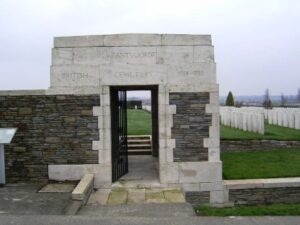
Alfred Gardner. Alfred cannot presently be identified.
Walter Gravenor, Private, 56980, Welsh Regiment. Walter was the son of John and Mary Gravener, of Dutlas. He enlisted at Knighton into the Montgomeryshire Yeomanry on 31 May 1915 and on 9 August 1916 arrived in France, where he was attached to the 10th Battalion, Welsh Regiment. The Battalion was attached to 114 Brigade, 38th (Welsh) Division and had just been moved to Hébuterne after a torrid time capturing Mametz Wood. Shortly afterwards the division moved to Ypres, to take up the line at Boesinghe, along the Ieperlee Canal. Walter became ill here during the winter, suffering a spell of tonsillitis, he later contracted trench fever and was returned to England on 14 February 1917. On 11 June 1917 Walter arrived back in France and was sent along with a number of drafts to the 17th Battalion, Welsh Regiment, which was attached to 119 Brigade, 40th (Bantam) Division. He joined the battalion at Villers-Plouich. A few days later the battalion took over positions at Gonnelieu. Walter was probably killed during a night patrol, in the morning of 22 July 1917. The 28-year-old is buried in Honnechy British Cemetery, France. Walter is also commemorated on the Knighton War Memorial.
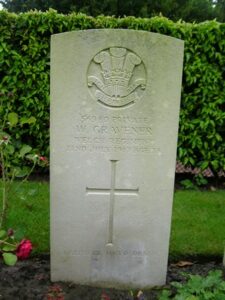
William Edward Gwilt, Private, 84997, The King’s (Liverpool Regiment). William was the son of John and Mary Ann Gwilt, of Tregodfa, Llanfair Waterdine. He originally enlisted at Waterford into the 16th Lancers, but was later posted to the 1st Battalion, The King’s (Liverpool Regiment). The battalion was attached to 6 Brigade, 2nd Division. William would have embarked for France quite late in the war, possibly in time to take part in the Battle of Cambrai. The division was still in the Cambrai sector when it was caught up in the German spring offensive which was launched on 21 March 1918, and saw heavy fighting during the withdrawal which followed. From 21 August onwards, it took part in the great offensive, helping push the Germans back towards the mighty Hindenburg Line. William was killed in action two days into the offensive, on 23 August 1918, aged 40. He has no known grave and is commemorated on the Vis-en-Artois Memorial, Haucourt, France.
Henry Hamer, Private, 291240, Welsh Regiment. Henry was the son of John and Annie Hamer, of Beguildy. He enlisted into the army and was posted to the 7th Battalion, Welsh Regiment, a Territorial unit. Henry was posted to France at some time, joining the 9th Battalion, Welsh Regiment, which was attached to 58 Brigade, 19th (Western) Division. He possibly saw his first major action at the Battle of Passchendaele. By the following spring the division was in the Somme sector and got caught up in the German spring offensive which was launched on 21 March 1918. Fighting a stubborn withdrawal over the coming days, the division suffered terribly, before being relieved and moved to the Lys to recover. Unfortunately, the Germans launched the second phase of their 1918 offensives along the Lys valley on 9 Apriln and the 19th Division became caught up in terrible fighting again, before being moved to the peaceful Aisne sector to rebuild, but were caught up in the German offensive on the Aisne. Following this, the battered division was moved back north to rebuild and did not see action again until taking part in the great offensive from 21 August onwards. By this time, Henry was in Germany, he had been taken prisoner, probably on the Aisne, and was in a prisoner of war camp. He died in Niederzwehren, Germany on 21 August 1918, aged 30, and is buried in Niederzwehren Cemetery, Kassel, Germany.
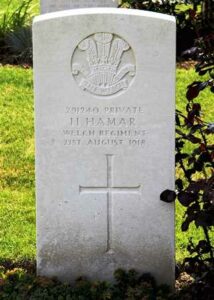
William Jones, Private, 10439, South Wales Borderers. William was the son of Anne Jones, of Lower Drifth, Churchstoke. His brother, Alfred, lived in Beguildy, where he worked as a farm hand. William was a regular soldier, and was serving with the 1st Battalion, South Wales Borderers at the outbreak of war. He disembarked in France on 9 November 1914 to join the battalion, which had been in France with the 1st Division since 13 August, and joined the battalion at Ypres, where it had been moved following the Battle of the Aisne. The task for the 1st Division at Ypres was a difficult one. The Germans plan, the Schlieffen Plan, involved a drive through Belgium to cut off the Channel ports, so the Allies had built a defensive line east of the city of Ypres, to stop this from happening. The division suffered heavy casualties at the fighting at Langemarck from 21-24 October, and the 1st SWB, together with the 2nd Welsh and 2nd Worcesters, gained fame for holding the line at Gheluvelt following an overwhelming German attack on 31 October 1914. William joined the battalion at Outtersteene as part of a large number of drafts sent out to rebuild the battered battalion after its ordeals. He is officially recorded as being killed in action on 21 December 1914, although according to the battalion war diary, the battalion did not return to action until the following day, during an attack at Festubert. William has no known grave and is commemorated on the Le Touret Memorial, Richebourg-L’avoue, France. He is also commemorated on the Welshpool War Memorial.
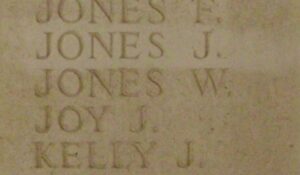
William Lloyd, Private, 54568, Royal Welsh Fusiliers. William was the son of John David and Mary Elizabeth Lloyd, of Pwmyringel, Beguildy. He enlisted at Welshpool into the army and was posted to France at some time in 1916, joining ‘A’ Company, 2nd Battalion, Royal Welsh Fusiliers. The battalion was attached to 19 Brigade, 33rd Division and moved from the Cambrin area in July 1916 in order to take part in the Somme offensive. The division saw heavy fighting on the Somme, especially around High Wood and the following year moved to Arras, taking part in heavy fighting at Hindenburg Trench. Later that year the division moved north and spent some time in the trenches on the French coast, before moving to Ypres in September to take part in the Battle of Passchendaele. The 2nd RWF moved into the support line behind Glencorse Wood on 25 September and on the following morning, 26 September 1917, advanced past the north of the wood to launch an assault on Polygon Wood. William was probably killed when ‘A’ Company came under heavy fire near Lone Farm that morning, suffering a number of casualties. He was 21 years old and is commemorated on the Tyne Cot Memorial, Belgium. William is also commemorated on war memorials at Newtown and Welshpool.
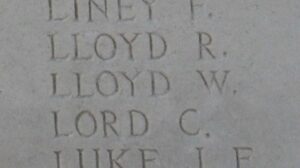
Charles Morris, Private, 56827, Royal Welsh Fusiliers. Charles was born at Knucklas in 1889, the son of George and Helen Morris. His parents later moved to Woodville Grove, Stowe, where Charles later worked as a coachman. He enlisted at Newtown into the Welsh Horse Yeomanry, but was later transferred to the 25th Battalion, Royal Welsh Fusiliers, which was in Egypt attached to 231 Brigade, 74th (Yeomanry) Division, having been newly formed from Yeomanry battalions in March 1917. The newly formed 231 Brigade assembled at Khan Yunus during the first week of April 1917 and the division began to relieve other units in the front line, which had been taking part in the First Battle of Gaza, the offensive into Palestine. The battle had been a disaster for the Allies and a second offensive, the Second Battle of Gaza, was planned for 17 April. The 74th Division was held in reserve for the attack, and on 20 April began to advance. Lord Kensington led the 25th RWF forwards under heavy shellfire, and it was soon realised that this second attempt had also failed. Charles was wounded during this move forwards and died of his wounds at the 231st Field Ambulance, Palestine on 24 April 1917, aged 26. He is buried in Gaza War Cemetery.
John Marsh Price, Private, 27816, Royal Warwickshire Regiment. John, known as Marsh, was the son of Mrs. Price, of Felindre. He was raised by his grandparents John and Elizabeth Price, at Stone House, Beguildy. Marsh enlisted at Hereford into the Herefordshire Regiment, before being transferred to the 1st Battalion, Royal Warwickshire Regiment, which was attached to 10 Brigade, 4th Division. He probably joined the battalion on the Somme in 1916, where the division took part in the Battle of Le Transloy. In April 1917 the division took part in the Battle of Arras, before moving north to take part in the Third Battle of Ypres. The division was near the Hindenburg Line when the Germans launched their spring offensive on 21 March 1918, and the 4th Division became caught up in heavy fighting, before moving to Flanders, and playing a role in the Defence of Hinges Ridge. From 21 August onwards the division took part in the advance in Flanders, launching their advance from the area around Lillers. By the 28th the 1st Warwick’s had reached the village of Vis-en-Artois and by 30 August 1918 were readying for an assault on Remy Wood and village. Marsh was killed in action that day, during heavy fighting. He was 25 years old, and is commemorated on the Vis-en-Artois Memorial, Haucourt, France.
William Lloyd Price, Private, 55075, Royal Welsh Fusiliers. William was the son of William and Jane Price, of Lane House, Felindre. He was raised by his grandmother, Mary Griffiths, at Rhuvid Farm, Beguildy, where he worked as a cowman. William enlisted into the Monmouthshire Regiment, but after being drafted to France was posted to the 10th Battalion, Royal Welsh Fusiliers, which was attached to 76 Brigade, 3rd Division. He probably joined up with the battalion following its ordeals on the Somme, during the heavy fighting in Delville Wood in July 1916 which saw the award of two VC’s to men of the battalion. The division took part in the Battle of the Ancre later in 1916, before settling into another bleak winter in France. By mid-February 1917 the Division was at Arras, beginning what would be a long spell, which would see them taking part in the forthcoming Battle of Arras. On 6 April the battalion marched from billets at Wanquetin for Arras where it billeted overnight before moving to Tilloy on the following day. At 05.30 on 9 April 1917 the battalion launched its attack, and within an hour had captured its objectives, before consolidating their new positions. William was wounded during the day and was evacuated to a casualty clearing station where he died of his wounds on 11 April 1917, aged 22. He would have been buried near to the place he died, but the area was heavily fought over again the following year, and as a result William is commemorated to the Arras Memorial, France.
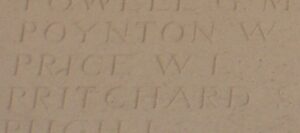
George Harris Pryce, Private, 237155, King’s Shropshire Light Infantry. George was the son of Thomas Harris Pryce and Mary Elizabeth Pryce, of Bridge House, Felindre. He enlisted at Knighton into the King’s Shropshire Light Infantry, and after training at Pembroke Dock was posted to their 7th Battalion, which was attached to 76 Brigade, 25th Division. The Division moved to France in September 1915, with the 7th KSLI being transferred to the 3rd Division within weeks of arrival. The battalion saw its first action at the Hohenzollern redoubt, at Loos. In 1916 the Division moved south to the Somme, where they fought during the opening of the Somme Offensive at the Battle of Albert, then at Bazentin Ridge and at Pozieres. They then took part in the Battle of Delville Wood, and the Battle of the Ancre, before settling into another bleak winter in France. The Division fought at Arras and Ypres in 1917, and saw action during the German Offensive of 1918. On 21 August 1918, the Division took part in the opening of the Battle of Albert. George was killed that day, aged 32, and is buried at Bucquoy Road Cemetery, Ficheux, France.
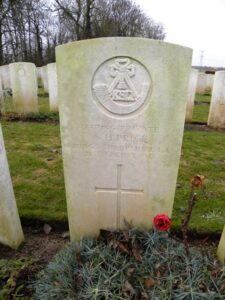
Ernest Whittall, Private, 2935, Montgomeryshire Yeomanry. Ernest was born at Beguildy in about 1882, the son of Richard Whittall. He was raised by his aunt, Hannah Brick, at Acton, Lydbury, before becoming a farm worker at Gunridge, Clunton. Ernest enlisted at Shrewsbury into the 4th Battalion, King’s Shropshire Light Infantry on 12 October 1914, but within less than a month had been deemed unfit and discharged. Undeterred, he re-enlisted into the Montgomeryshire Yeomanry at Knighton and was posted to Slwch Camp, near Brecon. Sadly, he became ill and was taken into the Depot Hospital at Brecon, where he died of pneumonia on 25 February 1916, aged 33. He was buried with full military honours in Brecon Cemetery. Ernest is not commemorated on the Beguildy War Memorial.
World War Two, 1939-1945
Thomas Norman Brace Jones, Marine, PLY/X 2881, Royal Marines. Thomas was born on 24 March 1921, the son of Amy Jones, of Rose Cottage, Dutlas, Radnorshire. He enlisted into the Royal Marines following the outbreak of war and was posted aboard the aircraft carrier HMS Hermes, the first ever one designed as such. Commissioned in 1924, Hermes served briefly with the Atlantic Fleet before spending the bulk of her career assigned to the Mediterranean Fleet and the China Station. She returned home in 1937 and was placed in reserve before becoming a training ship in 1938. When the Second World War began, Hermes was assigned to the Home Fleet, to carry out anti-submarine patrols, but was transferred to Dakar in October to cooperate with the French Navy. Following the fall of France, Hermes spent several months under repair in South Africa, following a collision, before being despatched to the South Atlantic and the Indian Ocean. Hermes supported Commonwealth forces in Italian Somaliland during the East African Campaign and did much the same two months later in the Persian Gulf during the Anglo-Iraqi War. After that campaign, Hermes spent most of the rest of the year patrolling the Indian Ocean. She was refitted in South Africa between November 1941 and February 1942 and then joined the Eastern Fleet at Ceylon. On 8 April 1942, Hermes was in Trincomalee, when warning of an Indian Ocean raid by the Japanese fleet was received, and she sailed that day for the Maldives with no aircraft on board. On 9 April a Japanese scout plane spotted her near Batticaloa, and she was attacked by several dozen dive bombers shortly afterwards. With no air cover, the carrier was quickly sunk by the Japanese aircraft, going down with the loss of 307 men. Thomas was 21 years old when he died during the sinking of Hermes on 9 April 1942, and he is commemorated on the Plymouth Naval Memorial, Devon.
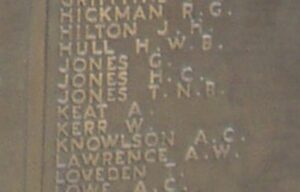
William Cyril Williams, Sergeant, 1410983, Royal Air Force Volunteer Reserve. William was the son of John and Sarah Williams, of Cross Gates, Llandrindod Wells. He enlisted into the Royal Air Force Volunteer Reserve and was posted to 1660, Heavy Conversion Unit, at RAF Swinderby, for training on the Avro Lancaster. On 6 July 1943 William was flying aboard Lancaster I, Serial R5736, when the aircraft crashed into the side of a hill near Llangernyw, 12 miles WNW of Denbigh, killing all six men aboard. William was 21 years old when he died that day and his remains were buried in St. Michael’s Churchyard, Beguildy. William is not commemorated on the Beguildy War Memorial, but is commemorated by a fine stained glass window within the Church.